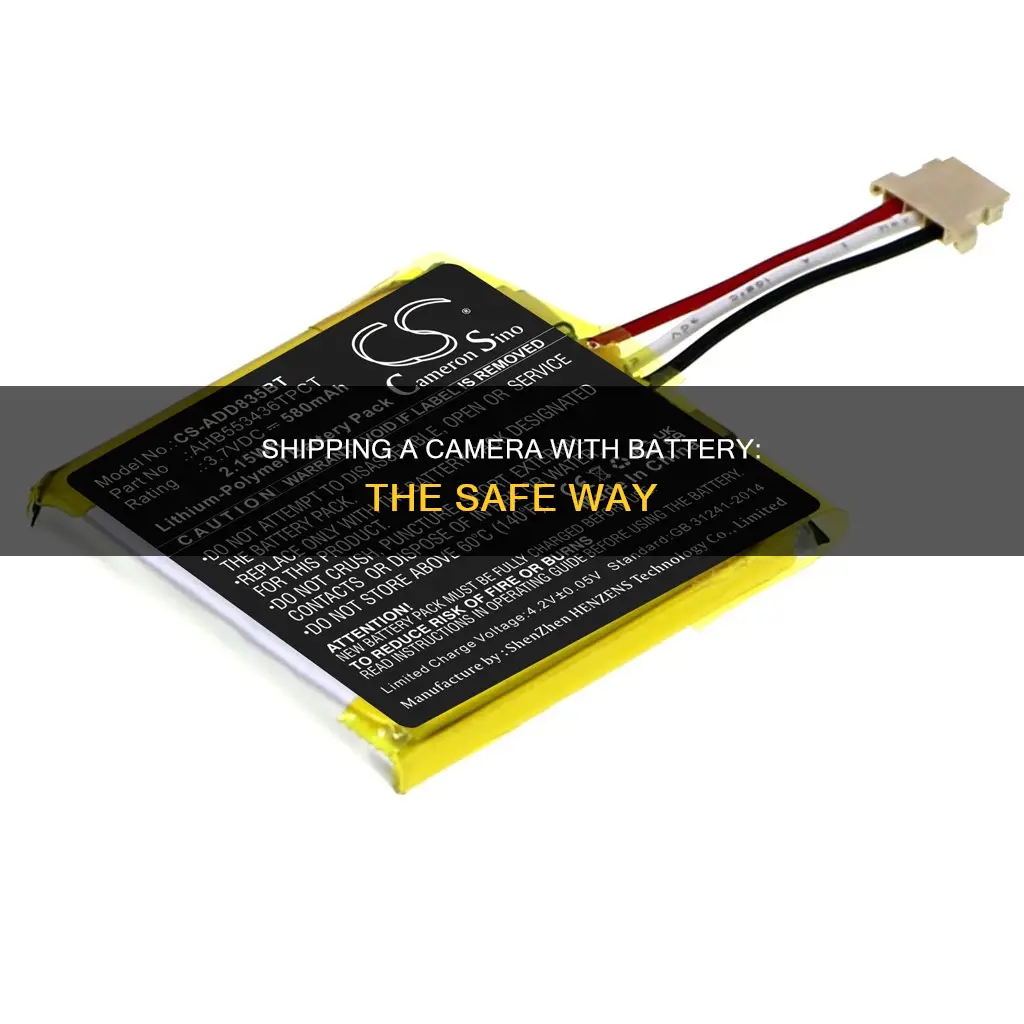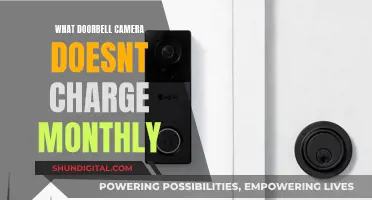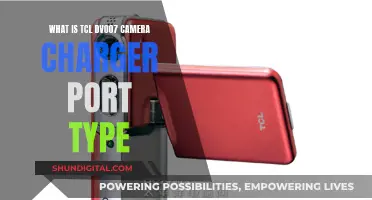
Shipping a camera with a lithium-ion battery requires careful adherence to safety guidelines. These batteries are classified as dangerous goods due to their highly flammable nature and sensitivity to environmental factors, which can lead to short-circuiting and potential fires if not packaged correctly. When shipping a camera with a lithium-ion battery, it is crucial to use a reputable courier with guidelines in place for handling such items. Additionally, specific packaging, labelling, and shipping methods must be followed to comply with regulations.
| Characteristics | Values |
|---|---|
| Weight limit | 35kg |
| Battery type | Lithium-ion |
| Packaging | Sturdy box with sufficient packing material |
| Number of batteries | No more than two in one package |
| Shipping method | Ground shipping |
| Labels | Lithium-ion battery safety document, lithium-ion battery handling label, class 9 lithium battery label |
What You'll Learn

Shipping a camera with a lithium-ion battery via USPS
When shipping a camera with a lithium-ion battery via USPS, there are a few things to keep in mind to ensure your package complies with postal regulations. Firstly, it is important to note that lithium-ion batteries are considered hazardous materials by USPS, and therefore, special handling and labelling are required.
If you are shipping a new camera with a new lithium-ion battery, you can use USPS Priority Mail without any issues. However, if the camera or battery is pre-owned, damaged, or defective, then according to USPS regulations, it must be sent via ground transportation and is prohibited from air transportation. This means that it cannot be shipped using Priority Mail, which includes air transportation. In this case, you will need to use a ground-only shipping option, such as Parcel Select.
To ensure your package is properly labelled, you can download and print a lithium battery label from the USPS website. This label should be affixed to the outside of your package to indicate that it contains lithium-ion batteries. Additionally, you may need to mark the box to indicate that it contains hazardous materials and must be shipped via ground transportation only.
When packaging your camera and battery, it is important to follow USPS guidelines for shipping lithium-ion batteries. The battery should be installed in the camera or packed with the equipment it is intended to operate. Ensure that the camera and battery are securely packaged and protected from damage during transit. You may want to consider using a sturdy box, such as a USPS flat-rate box, to provide adequate protection for your camera.
By following these guidelines, you can safely and securely ship your camera with a lithium-ion battery via USPS, ensuring compliance with postal regulations and peace of mind for yourself and the recipient.
Eufy Camera Charging: Know When It's Fully Charged
You may want to see also

The importance of labelling your package correctly
When shipping a camera with a lithium-ion battery, it is important to correctly label the package to ensure the safety of those handling it during transit and to comply with government and courier regulations.
Firstly, it is important to note that devices containing lithium-ion batteries are classified as dangerous goods due to their highly flammable nature and sensitivity to environmental factors. This means that they follow specific packaging and shipping regulations. For example, in the US, the Department of Transportation (DOT) has strict shipping requirements for lithium-ion batteries, including special packaging and labelling. Unless you are Hazmat trained, it is unlawful to ship lithium-ion batteries via air shipment in the US.
To correctly label a package containing a camera with a lithium-ion battery, you should include a Lithium Ion Battery Safety Document, a Lithium Ion Battery Handling Label, and a Class 9 Lithium Battery Label. These labels can often be downloaded and printed at home, and some courier services provide them at their locations. It is also important to label the shipment to indicate that it contains lithium-ion batteries or dangerous goods. This can help to ensure that those handling the package are aware of its contents and can take the necessary precautions.
In addition to correct labelling, it is crucial to package the camera and battery securely to prevent damage and short-circuiting during transit. This may include using a sturdy box, sufficient packing materials, and insulating, non-conductive materials to cover battery terminals.
Failure to comply with lithium-ion battery shipping regulations can result in serious consequences. Your shipment may be rejected by the courier, and you may be subject to fines or blacklisted from shipping in the future. In addition, incorrect labelling and packaging can pose safety risks, including the risk of fires or other dangerous situations. Therefore, it is essential to take the time to understand and follow the regulations when shipping a camera with a lithium-ion battery.
Charging the Kodak EasyShare Z650: A Step-by-Step Guide
You may want to see also

How to package your camera and battery safely
Lithium-ion batteries are classified as hazardous materials and must be packaged and shipped according to specific regulations. This is because they are highly flammable and can cause fires if not packaged correctly.
Firstly, it is important to note that you must use ground shipping for lithium-ion batteries and that you cannot ship them via air. You should also never ship damaged or defective batteries.
When packaging your camera and battery, you should place the battery inside the camera's battery compartment. The entire package should then be placed inside a sturdy box with sufficient packing material to prevent damage in transit. Do not ship more than two batteries in one package.
You must also label the package with the required warning labels, including a Lithium-Ion Battery Safety Document, a Lithium-Ion Battery Handling Label, and a Class 9 Lithium Battery Label. These labels can be downloaded and printed at home. Bring your unsealed package to a shipper like UPS, FedEx, or USPS, who can provide you with a tracking number. Inform the shipper that you are sending a lithium-ion battery and ask them to provide you with the necessary labels if you were unable to print them yourself.
To ensure the safety of your package, make sure that the battery terminals are covered with insulating, non-conductive materials to prevent short-circuiting. You should also avoid placing heavy items on top of the packed battery and keep the battery away from other metal objects.
Charging Drift HD Camera Batteries: A Step-by-Step Guide
You may want to see also

Shipping a camera with battery internationally
When shipping a camera with a battery internationally, there are a few things to keep in mind to ensure that your package complies with regulations and arrives safely at its destination. Here is a step-by-step guide:
Prepare the Camera and Battery:
- Remove any memory cards, straps, and flashes from the camera.
- If your camera has a lithium-ion battery, it should remain inside the camera. However, if it uses a different type of battery, it is recommended to remove and pack it separately.
- Ensure that the body cap is attached to protect the camera's mirror and sensor during shipping.
- Switch off the camera to prevent accidental activation during transit.
Packing the Camera:
- Wrap the camera and battery separately in bubble wrap. Use 2-3 layers of bubble wrap for the camera to provide adequate protection.
- Place the wrapped camera inside its case, if available, for extra protection.
- Use a sturdy, double-walled cardboard box as your outer packaging. Place the wrapped camera and battery inside the box, ensuring they are separated if the battery has been removed.
- Fill any empty spaces in the box with packing peanuts, crumpled paper, or other filler materials to prevent movement and provide cushioning.
- Seal the box securely with strong adhesive tape.
- Attach the appropriate shipping labels, including any "Fragile" or "Handle with Care" labels, and a clear address label.
Shipping and Regulations:
- Check the regulations of the destination country regarding the shipping of lithium batteries. Some countries may have specific restrictions or requirements.
- Select a reputable shipping carrier that allows for the transport of lithium-ion batteries. Some common options include FedEx, UPS, and DHL.
- Be aware of any restrictions on pre-owned, damaged, or defective electronic devices containing lithium batteries, as some carriers may prohibit their shipment via air transportation.
- Ensure that you comply with all applicable regulations, including the Lithium Battery Shipping Regulations, to avoid penalties and ensure the safety of your shipment.
By following these steps and staying informed about the specific regulations of your destination country, you can safely ship your camera with a battery internationally.
Charging Spy Button Cameras: A Step-by-Step Guide
You may want to see also

What to do if your package is damaged, defective or recalled
When shipping a camera with a lithium-ion battery, it's important to be aware of the specific regulations and guidelines to ensure safe and compliant shipping. Here are some detailed instructions on what to do if your package is damaged, defective, or recalled:
- Choosing the right box and packing materials: Select a box that is the appropriate size for your camera and battery. Ensure it is sturdy and securely seals to protect the contents. Use adequate packing materials such as packing peanuts or bubble wrap to cushion the items and prevent damage during transit.
- Shipping regulations and markings: Familiarize yourself with the shipping regulations for lithium-ion batteries. In some cases, you may need to mark the box to indicate that it contains a lithium-ion battery and specify ground transportation only. Check the regulations for your specific carrier, as they may have different requirements.
- Insurance and return policy: Consider purchasing shipping insurance to protect yourself financially in case of damage or loss. Additionally, have a clear and customer-friendly return policy in place, as this can reduce potential issues and improve customer satisfaction.
- Damage during transit: If your package is damaged during shipping, retain all original packaging, contents, and receipts. Contact the shipping carrier (FedEx, UPS, or USPS) to initiate a claim. Each carrier has its own process, which may include submitting claims online, via mail, or by phone. Provide any necessary documentation, such as proof of value, insurance, and evidence of damage.
- Defective or recalled items: If the camera or battery is defective or recalled, be sure to include this information in your return policy. Communicate clearly with your customers during the pre-purchase and buying processes to minimize issues. Set an appropriate timeline for returns and specify any conditions, such as returning the original packaging.
- Communicating with customers: Maintain open and transparent communication with your customers throughout the shipping process. Provide detailed product descriptions, images, and clear return and exchange policies. This can help manage customer expectations and reduce potential issues.
Amcrest Cameras: Are They Battery-Powered?
You may want to see also
Frequently asked questions
Devices that contain batteries are classified as dangerous goods and follow specific packaging and shipping regulations. Make sure to use a sturdy box with sufficient packing material to prevent damage in shipping.
Yes, it is important to label the shipment to make it obvious that it contains lithium batteries or dangerous goods.
No, unless you are Hazmat trained, it is unlawful to ship lithium-ion batteries via air shipment. Please use ground shipping.
Make sure that batteries and terminals are well protected to avoid short-circuiting. Cover terminals with insulating, non-conductive materials. Put a protective covering on the switches of any device with these batteries to prevent accidental activation while in transit.
Inform the shipper that a lithium-ion battery is being shipped. There are strict shipping requirements, including special packaging and labeling. Make sure to use a shipper who can provide you with a tracking number.







